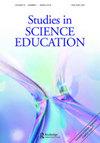调查小学基于项目的科学技术学习环境的质量:对工具的批判性回顾
IF 9.9
2区 教育学
Q1 EDUCATION & EDUCATIONAL RESEARCH
引用次数: 8
摘要
摘要本文提供了一个系统的回顾,有可能衡量的工具在小学基于项目的科学技术(S&T)学习环境的质量。为此,对大范围的科技学习环境进行了全面的文献检索。我们对检索到的仪器及其操作所测量的方面进行了水平的自下而上的分析。我们区分了11种成分。最常被评估的部分是先前的知识和背景,与现实的联系,作为探究的科学以及主动性和小组工作的水平。总体而言,结果表明在发现的组件的操作中存在相当大的多样性。特别是,对于与现实、作为探究的科学以及主动性和团队工作水平的联系,这与(1)测量对象(例如,评估方面的多样性)和(2)所使用的概念被澄清的程度有关。因此,我们发现一些量表、项目和问题比其他量表、项目和问题更符合基于项目的学习环境的各个方面。此外,大多数检索到的工具涵盖科学,而不是技术或基于项目的教育。当寻找一个量表、项目或问题来衡量科技学习环境的特定方面时,可以使用该综述。本文章由计算机程序翻译,如有差异,请以英文原文为准。
Investigating the quality of project-based science and technology learning environments in elementary school: a critical review of instruments
Abstract This paper provides a systematic review of instruments that have the potential to measure the quality of project-based science and technology (S&T) learning environments in elementary school. To this end, a comprehensive literature search was undertaken for the large field of S&T learning environments. We conducted a horizontal bottom-up analysis of the aspects measured by the retrieved instruments and their operationalisation. We distinguish 11 components. The most frequently evaluated components are prior knowledge and backgrounds, connection with reality, science as inquiry and level of initiative and group work. Overall, the results suggest a considerable diversity in the operationalisation of the components found. Particularly, for connection with reality, science as inquiry and level of initiative and group work, this is related to (1) the object of measurement (e.g. variety in aspects evaluated) and (2) the extent to which the used concepts are clarified. Consequently, some scales, items and questions were found to be a closer fit with aspects of project-based learning environments than others. Additionally, most of the retrieved instruments cover science and not technology or project-based education. This review can be used when searching for a scale, item or question to measure particular aspects of S&T learning environments.
求助全文
通过发布文献求助,成功后即可免费获取论文全文。
去求助
来源期刊

Studies in Science Education
EDUCATION, SCIENTIFIC DISCIPLINES-
CiteScore
15.30
自引率
2.00%
发文量
7
审稿时长
>12 weeks
期刊介绍:
The central aim of Studies in Science Education is to publish review articles of the highest quality which provide analytical syntheses of research into key topics and issues in science education. In addressing this aim, the Editor and Editorial Advisory Board, are guided by a commitment to:
maintaining and developing the highest standards of scholarship associated with the journal;
publishing articles from as wide a range of authors as possible, in relation both to professional background and country of origin;
publishing articles which serve both to consolidate and reflect upon existing fields of study and to promote new areas for research activity.
Studies in Science Education will be of interest to all those involved in science education including: science education researchers, doctoral and masters students; science teachers at elementary, high school and university levels; science education policy makers; science education curriculum developers and text book writers.
Articles featured in Studies in Science Education have been made available either following invitation from the Editor or through potential contributors offering pieces. Given the substantial nature of the review articles, the Editor is willing to give informal feedback on the suitability of proposals though all contributions, whether invited or not, are subject to full peer review. A limited number of books of special interest and concern to those involved in science education are normally reviewed in each volume.
 求助内容:
求助内容: 应助结果提醒方式:
应助结果提醒方式:


